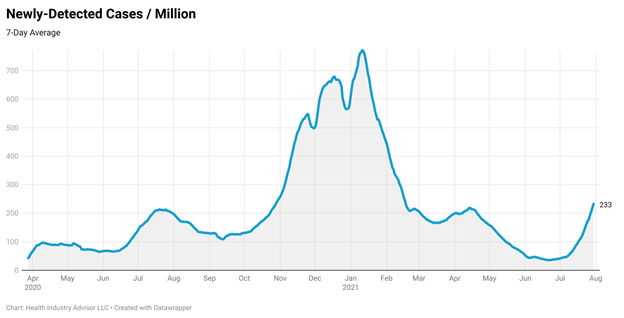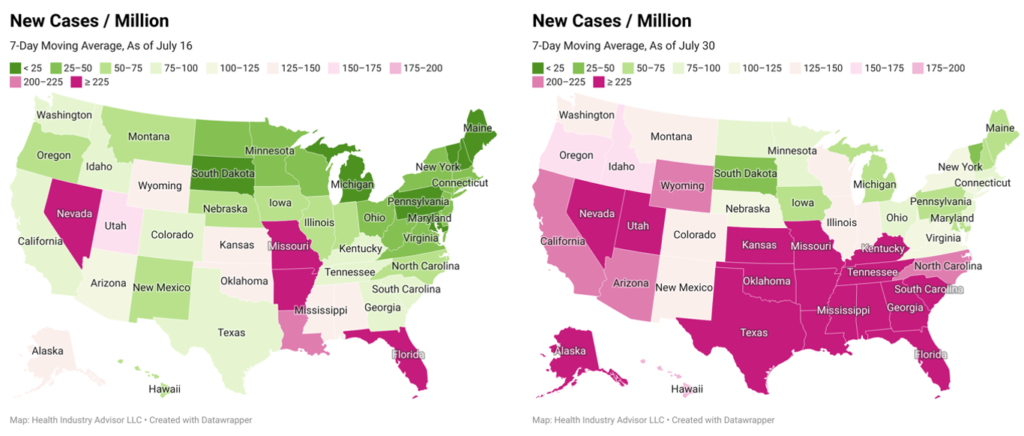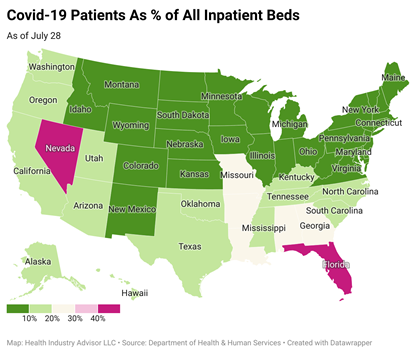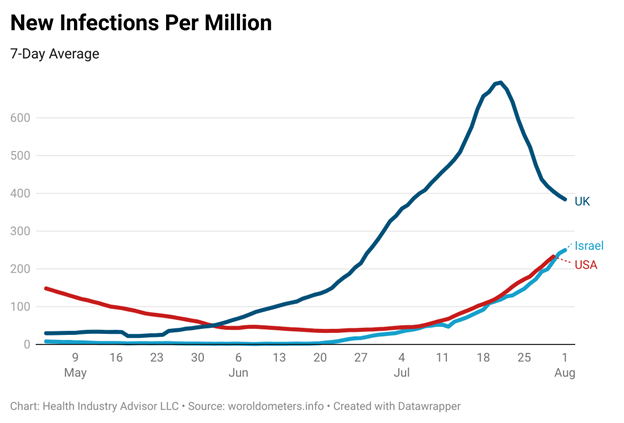August 2, 2021 – COVID infections in the United States spiked at an unprecedented rate during July. At one point mid-month, new cases surged 70% from one week to the next. The South suffered greater than the rest of the country, with Florida and Texas accounting for nearly one-third of all new infections reported during July. Nonetheless, underlying trends point to slowing infection spread and perhaps declining new daily cases within a few weeks.
The following charts illustrate the rapid growth in new infections. Since reaching a pandemic low on June 21, new daily infections increased more than five-fold in 40 days. The current rate exceeds last summer’s peak yet, remains only a third of its early January peak.

Infections have surged across the country. Comparing infection rates from just two weeks ago to now demonstrates how quickly the virus has spread.

Fortunately, surging infections have not resulted in comparable spikes in hospitalizations or deaths with COVID. The daily average death total rose by one-third in the past three weeks – a pace 70% slower than the preceding infection growth. Similarly, despite infections more than five times higher than a month ago, COVID hospital census “only” doubled.
Still, the virus is stressing hospitals and staff in several parts of the country.
Eight states are devoting at least one of every five inpatient beds to treating COVID patients. Nevada (49% of inpatient beds occupied by COVID patients) and Florida (46%) are under the most significant stress.
In Alabama, Arkansas, Georgia, Louisiana, Missouri, and Texas, rates vary between 20-24%.
Nationwide, 14% of inpatient beds are in use by COVID patients.

How long will this surge last?
Over the weekend, Dr. Anthony Fauci posited that infections would continue to spike in the United States. Conversely, Dr. Scott Gottlieb, former head of the FDA, hypothesized those daily infections would recede within two to three weeks.
They both may be right.
Each COVID infection surge has followed a similar pattern: infections accelerate for several weeks before falling back to pre-surge levels. The most prolonged surge in the United States occurred from September 2020 through early January. Notably, there were no vaccines available to moderate this surge. Most waves here and in other countries have lasted one to two months.
The Delta variant produced intense surges in both India and the United Kingdom. In both countries, the waves lasted about two months. Further, both countries experienced rapid ascending infections, followed by similarly quick descending infections.
The following chart illustrates infection rates in Israel, the United Kingdom, and the United States. The infection surge in the United Kingdom commenced about one month earlier than in Israel and the United States. Lasting about two months, the United Kingdom’s wave peaked on July 21. New infections then plunged by half in just eleven days.

Will the United States (and Israel) follow a similar pattern as the United Kingdom? Doing so would mean that infections would surge for another three weeks or so, with daily infections significantly higher than today (supporting Dr. Fauci’s projection). Nonetheless, these countries could gain relief in the form of declining new infections by the third week of August (supporting Dr. Gottlieb’s expectation).
We found evidence corroborating Drs. Fauci’s and Gottlieb’s views. When analyzing past surges, we discovered that a coming peak in new cases is “telegraphed” weeks in advance. The key comes in watching the rate at which new cases increase each day. Early in each surge, new cases grow at an increasing rate every day (no doubt reflecting the high transmission rate of the virus). However, this rate starts decelerating during the middle of the surge. The deceleration point is the signal that declining new cases are on the horizon. (Of course, new cases still increase for several weeks, just at a slower rate. Ultimately, this slowdown translates to declining new cases.)
The chart below illustrates how this pattern is underway in the United States. The rate of increase in new cases began dropping on July 15. This followed four weeks of accelerating new cases. Should this pattern continue, we can reasonably assume that new cases could peak in the next few weeks.
We also depict the experiences in Florida and Texas, as these states accounted for one-third of all new cases in the United States in July. Like the United States as a whole, Florida saw its rate of infection increase peak on July 15. Texas’s peak occurred a few days later.

Of note, the Institute for Health Metrics and Evaluation’s (IHME’s) latest projection has Florida’s new cases peaking this Wednesday and Texas’ by August 13. Stress on the healthcare system continues for another few weeks: IHME predicts that the COVID census in each state will not peak until at least two weeks after new infections begin to fall.
In sum, the Delta variant will continue to drive new infections in the United States for at least a few more weeks. However, by mid-to-late August, we could begin to see some relief.
Contributing writer:
Mark A. Van Sumeren, strategic advisor, Medical Devices & Integrated Delivery Networks
Health Industry Advisor LLC, provides a regular report on COVID-19 numbers for the health care industry.
For more information, or to sign up for the report, contact Mark at Mark.VanSumeren@HealthIndustryAdvisor.com; or visit www.HealthIndustryAdvisor.com.
Filed Under: Repertoire’s Dail-eNews

